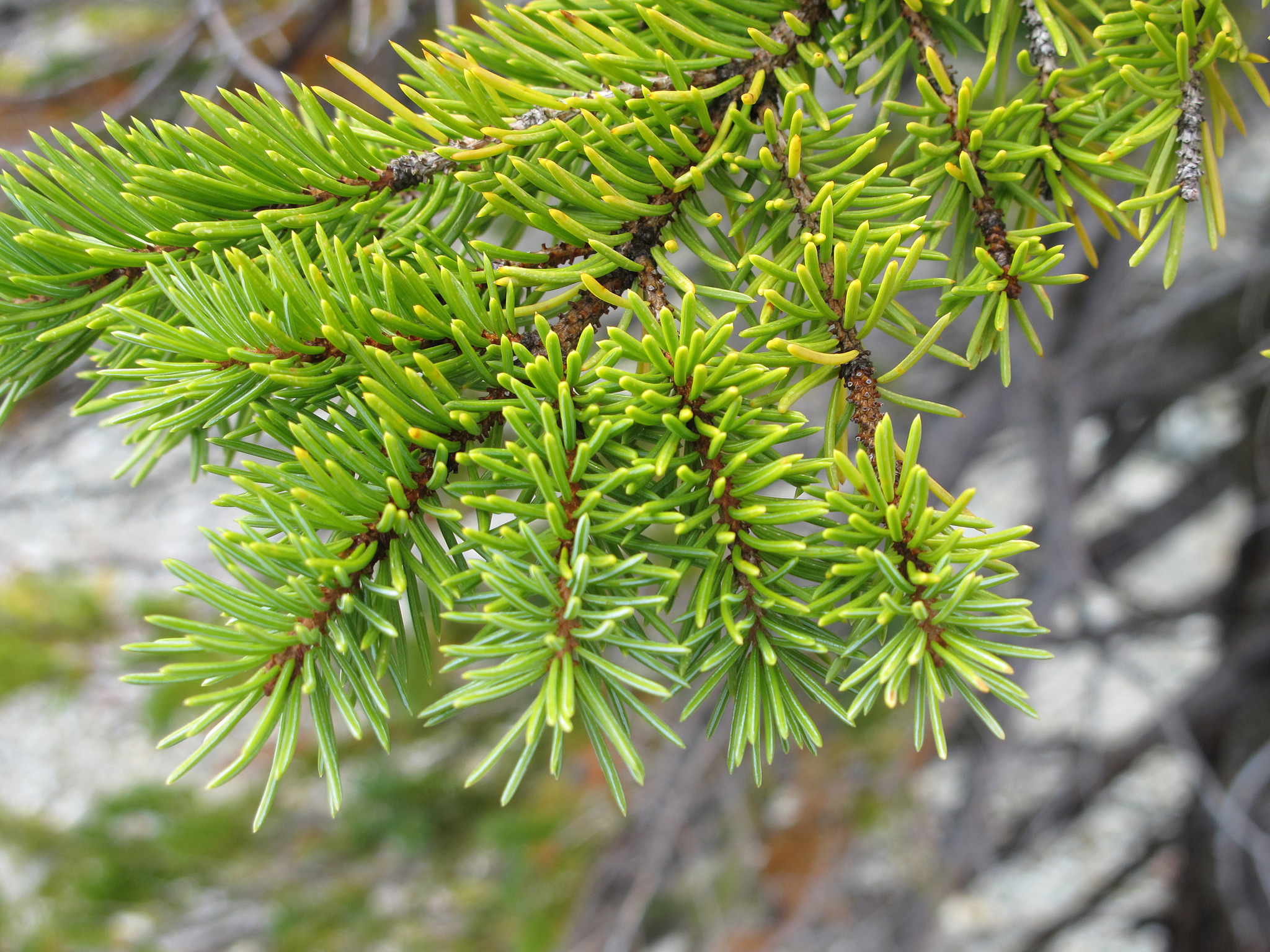Pinaceae of Greater Yellowstone Ecosystem
As with all the guides I have created, this is my best attempt to help distinguish species found within the Greater Yellostone Ecosystem, but may not be completely accurate. I welcome corrections and additional information that may improve identifications.
Pinaceae - Pine Family
- Includes pines, spruces, firs, and douglas firs.
- Pines (Pinus) are easily usually easily distinguished from other members of this family by needles that grow in bunches called fascicles.
- Because of the number of Pinus species the Greater Yellowstone Ecosystem they are covered in this separate guide.
Picea - Spruces
- Range
- Shared features: Sharp needles, square in cross section, attached with woody peg-like structure. When the needles fall off, the pegs remain, creating a bumpy texture on the twig. Mature cones have papery scales and hang below branches.
- The two species that are most likely to be confused in this area are the Engelmann and Blue Spruce - this post from Forage Colorado provides an excellent overview of their similarities and differences.


Photo 1 - Engelmann Spruce needle attachment - Source, Photo 2 - Engelmann Spruce Cones - Source
Picea engelmanni - Engelmann Spruce


Photo 1 Source, Photo 2 Source
- Range: throughout the Greater Yellowstone Ecosystem
- Observations of Picea engelmanni in the Greater Yellowstone Ecoystem
- Identification Resources: Forage Colorado-Blue Vs Engelmann Spruce, Gymnosperm Database, Picture of seed cones and pollen cones, JH Wildlife, SW Colorado Wildflowers
- Flexible needles, with stomates on all sides, grow at 45 degree angle to the twigs and branches. While still pointed like other spruces, needles can appear rounded in photos from some angles. Tend to feel less sharp than Blue Spruces (P. pungens). Seed cones are usually 1.5-2.5 inches long (which is shorter than P. pungens). Dominant spruce at higher elevations and on alpine slopes. Trunks tend to not have new growth branches. the bark of mature trees can have a reddish hue. New growth twigs will be hairy (hard to see in photos).
Picea pungens - Blue Spruce


Photo 1 Source, Photo 2 Source,
- Range:
- Identification Resources: Forage Colorado-Blue Vs Engelmann Spruce, Gymnosperm Database, JH Wildlife, SW Colorado Wildflowers
- Observations with comments: Comment on seed cone width,
- Not always blue, but when the blue hue is present, it can be helpful for ID. The blue hue is found more often in commercially grown trees. Stiff, blue-green needles, with stomates on all sides, grow at 90 degree angle to the twigs and branches. Tend to be sharper feeling than Engelmann Spruces. Growth habit is broadly conical (so wider than P. engelmanni) with branches that droop to varying degrees. Trunks tend to have new growth branches sprouting. New growth twigs are glabrous (not hairy). Buds are orange-brown, and pollen cones are red. The seed cones are generally longer than with P. engelmanni, 3-4 inches. More likely found at lower elevations, in valleys and bottomlands.
Picea Glauca - White Spruce
- Range: More common in Canada. Not common, but can be found in all MT counties in the GYE; Park County, WY; potentially present in Sublette County, WY; rare in Fremont County ID.
- Identification Resources: Gymnosperm Database, Montana Field Guide
- Observations of within the Greater Yellowstone Ecosystem - as of June 2023, no verifiable observations are at research grade. Observations in the GYE I suspect as being accurately ID as P. glauca include: this one and this one.
- Seed cones are green to violet, maturing to light brown, 1-2.5 inches long with rounded scales widest at the apex. Bruised needles emit a smell similar to cat urine or skunk. Needles are stiff (similar to blue spruce), but a bit rounded (more similar to Engelmann).
Abies - Firs
Abies lasiocarpa spp. bifolia (Subalpine Fir )



Photo 1 Source, Photo 2 Source, Photo 3 Source
- Shown as Abies bifolia on BONAP
- Observations of Abies lasiocarpa in the Greater Yellowstone Ecoystem
- Observations with comments: https://www.inaturalist.org/observations/148136391,
- Identification Resources: FNA, Gymonsperm database, US Forest Service, JH Wildlife
- Conical growth habit maybe flattened or irregular in older trees. Stiff straight branches with twigs opposite or whorled. Dark purple, cylindrical cones grow up from branches. Flat needles are glaucous green above with a broad stripe of stomata, and two blue-white stomatal bands below. The needles curve toward the opposite side of the twig. Round buds may be hidden by needles. Bark often has pockets of resin or many irregular horizontal lines. When a needles is removed, a fresh leaf scar reveals a yellow or tan periderm.
- Comment on how to distinguish from white fir: https://www.inaturalist.org/observations/100020308
Pseudotsuga - Douglas Fir
Pseudotsuga menziesii (Common Douglas Fir)



Photo 1 Source, Photo 2 Source, Photo 3 Source
- Range: Throughout the Greater Yellowstone Ecosystem
- Observations of Pseudotsuga menziesii in the Greater Yellowstone Ecoystem
- Observations with comments: https://www.inaturalist.org/observations/112163084
- Resources: Gymonsperm database, US Forest Service, JH Wildlife
- Flat needles with uniform color, attached by petiole with radial distribution around twigs. Seed cones are green when immature and brown when mature. They contain distinctive bracts with 3 points. Yellow-red pollen cones. Sharp pointed buds. Bark of mature trees has longitudinal fissures.





